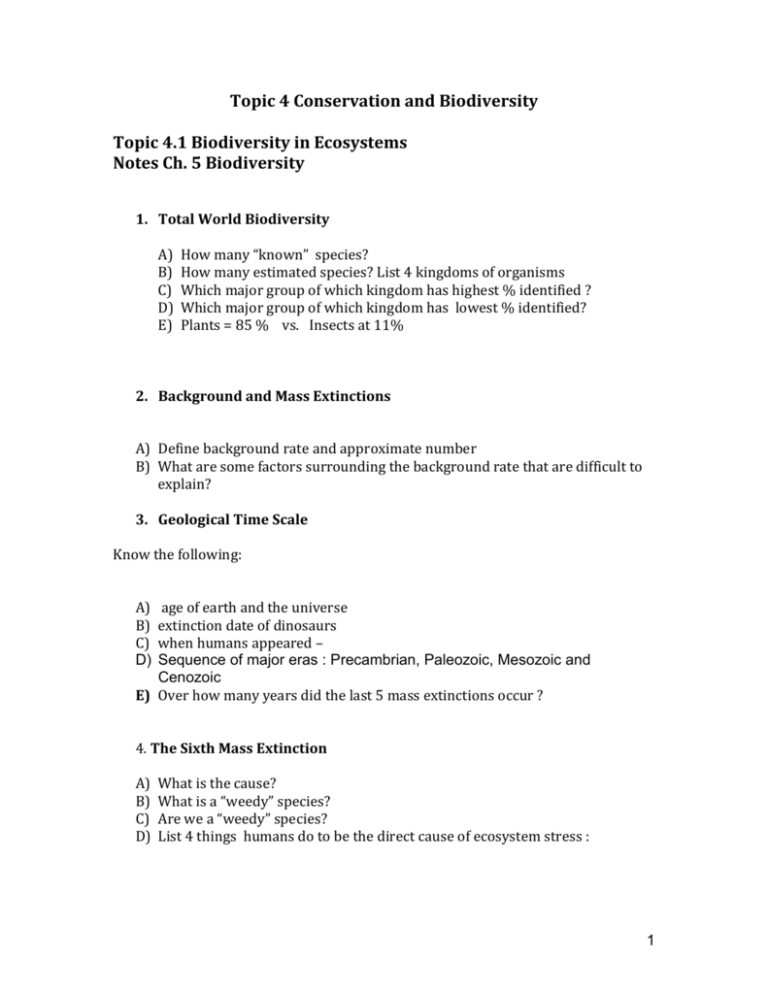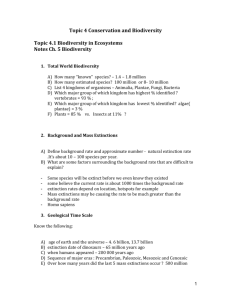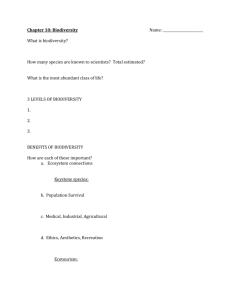Review Questions Topic 4
advertisement

Topic 4 Conservation and Biodiversity Topic 4.1 Biodiversity in Ecosystems Notes Ch. 5 Biodiversity 1. Total World Biodiversity A) B) C) D) E) How many “known” species? How many estimated species? List 4 kingdoms of organisms Which major group of which kingdom has highest % identified ? Which major group of which kingdom has lowest % identified? Plants = 85 % vs. Insects at 11% 2. Background and Mass Extinctions A) Define background rate and approximate number B) What are some factors surrounding the background rate that are difficult to explain? 3. Geological Time Scale Know the following: A) B) C) D) age of earth and the universe extinction date of dinosaurs when humans appeared – Sequence of major eras : Precambrian, Paleozoic, Mesozoic and Cenozoic E) Over how many years did the last 5 mass extinctions occur ? 4. The Sixth Mass Extinction A) B) C) D) What is the cause? What is a “weedy” species? Are we a “weedy” species? List 4 things humans do to be the direct cause of ecosystem stress : 1 E) Hotspots : Define the criteria that determines if an area is a Hotspot or not. F) Define endemic species – 5. Keystone Species – Types of Diversity A) Define Keystone species and give 2 examples. B) Explain biodiversity . Define three types of biodiversity with one example of each. 1. Species diversity – 2. Genetic diversity – 3. Habitat diversity – 6. How New Species Form / Plate Influence on Biodiversity A) Explain speciation related to NATURAL SELECTION . Use the following in your explanation : - geographical or reproductive barriers genetic variation and competition among individuals and how this may lead to speciation limited resources natural selection as a major force for speciation and EVOLUTION. how fast is speciation? briefly explain 2 specific examples of speciation Isolation leads to new species in general B) Plate Influence and Continental Drift on Biodiversity Explain effect of plate tectonics and continental drift on Llamas and camels – Kangaroos and cattle – 2 7. Factors that affect Biodiversity A) B) C) - List the factors that maintain biodiversity : List the factors that lead to a loss of biodiversity : Vulnerability of tropical rainforests: what may happen in 50 years contain ___ % of earths’ timber once cleared rain forest can only grow crops for about two years , why? 8. Extinction List the factors that make some species vulnerable to extinction ( make sure you understand them). Think of some examples. a) b) c) d) e) f) g) h) i) j) k) Narrow geographical range Small population – Low population densities and large territories – Few populations of the species Large Top predators Low reproductive potential Seasonal Migrants – Poor dispersers Specialized feeders or niche requirements hunted for food or sport Human activity causes extinction to occur faster vs. slower extinction rates due to natural causes 9. Case Studies Find an example of one that is not in the textbook. Write a brief explanation of: a) Description b) Ecological Role c) Pressures d) Method of Restoring Populations or reason species became extinct 3 Topic 4- Conservation and Biodiversity Notes ch. 6 – Conservation of Biodiversity 1. a) b) c) d) e) f) g) h) Definitions Red lists Bio right Conservation Preservation CITIES UNEP, WWF, GREENPEACE,IUCN NGO – GO Corridor 4 2. Why Conserve Biodiversity? Arguments – Economic Reasons a) Explain direct value and give one example of a food source and one example of a natural product. b) Explain indirect value and give 1 example : c) Make sure you know and understand the following types of indirect values: i) Ecosystem productivity – what is the main topic sentence? “ecosystem productivity gives us environmental stability and recycles materials. “ They are very complicated and rely on many species, biotic and abiotic factors. Pollination depends on insects, plants capture carbon and release oxygen. Climate is regulated by rainforests and vegetation cover. ii) Scientific and educational value : make sure you know and understand examples listed in textbook. Add aesthetic values ( not in textbook). Biological control agents- ladybirds eat pests called aphids Genes- hybrids, gmos, genetic engineering Environmental monitors – miners used canaries to test for toxic gases Recreational – parks, ecotourism Human health – medicines, medicinal plants, cure for cancer – amazon Human rights – preserve rainforests to preserve Indians Ethical/ aesthetic/ intrinsic value – humans are responsible for nature Biorights – preserve ecosystems as a whole and reduce $$ and need to concentrate on single species later on 3. Conserving and Preserving Biodiversity Conservation biology vs. preservation biology : explain the difference and give an example. 4. Methods : explain each A) Conservation Organizations- GOs, NGOs , WWF, IUCN, GREENPEACE, UNEP. Do Which is which research p. 122 of text. Table 6.1 good : how GOs and NGOs compare : 5 Media – GO prepare and read written statements – typical politicians. NGOs use media to gain attention – typical journalists Speed of response - GOs slow as always. NGOS faster Political constraints – GOs a lot .NGOs none Enforceability – GOs International agreements and laws. NGOs none, use public opinion to put pressure on GOs. WWF and GREENPEACE – NGOS UNEP ( from Wikipedia) - The United Nations Environment Programme (UNEP) coordinates United Nations environmental activities, assisting developing countries in implementing environmentally sound policies and practices. It was founded as a result of the United Nations Conference on the . Its activities cover a wide range of issues regarding the atmosphere, marine and terrestrial ecosystems. It has played a significant role in developing international environmental conventions, promoting environmental science and information and illustrating the way those can work in conjunction with policy, working on the development and implementation of policy with national governments and regional institution and working in conjunction with environmental Non-Governmental Organizations (NGOs). UNEP has also been active in funding and implementing environment related development projects. IUCN ( from Wikipedia) - The International Union for Conservation of Nature and Natural Resources (IUCN) is an international organization dedicated to finding "pragmatic solutions to our most pressing environment and development challenges." [1] The organization publishes a "Red List" compiling information from a network of conservation organizations to rate which species are most endangered.[ B) Red Lists – produced by the IUCN is a collection of threatened species lists under varying levels of threat to their survival. C) Species based conservation – the CITIES agreement The Convention of International Trade in Endangered Species. Species were becoming extinct due to buying and selling on a global scale for example, selling Blue Parrots from Brazil. Has about 5000 animal species and 28 000 plant species on list against law to sell. Since 1975 has been the most effective international wildlife agreement in the world. 6 D) Captive breeding programs and zoos Not very successful. Zoos are nice but not effective. Reintroducing animals into wild is expensive and only a few successful stories ( eg. Condor in California, Tamarin Lion in Atlantic Rain forest). Sometimes reintroducing an animal is impossible because original habitat has been wiped out. But what are the alternatives? Text doesn’t give any. E) Botanical gardens and seed banks ( basically gene banks) Plants are definitely easier to reintroduce to wild than animals. There are many seed banks and botanical gardens around the world and the future for preservation and conservation is much brighter than for animals. However , entire forests and ecosystems still have a huge problem. F) Gene banks – may keep DNA for recreating later on but technology still far away. G) Designing Protected Areas – Criteria Read pp. 128 – 129 of text; See fig. 6.6 explain following criteria: 7 Size – bigger is usually better because it minimizes edge effects. Smaller sometimes better due to more diversity in habitat Shape – circular usually better to minimize edge effects ( ectozones) . Actually based on what is available so most parks are irregular in shape. Edge effects- where 2 habitats meet and you get a mix of abiotic factors ( weather, precipitation wind etc. ) occurring at the ectozones. More different kinds of species will meet at the edges but this will create competition and predation which is not good for conservation of all species. Corridors - narrow strips of land that connect different park reserves. Worked well in Costa Rica and other countries but does have some disadvantages: - diseases can spread form on reserve to another easy access by hunters and poachers Proximity - basically the way areas are grouped together see fig. 6.6 above 8 5. Case Studies - know 9








